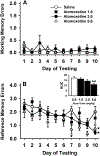Atomoxetine improves memory and other components of executive function in young-adult rats and aged rhesus monkeys
- PMID: 31108108
- PMCID: PMC6839761
- DOI: 10.1016/j.neuropharm.2019.05.016
Atomoxetine improves memory and other components of executive function in young-adult rats and aged rhesus monkeys
Abstract
Atomoxetine is a norepinephrine reuptake inhibitor and FDA-approved treatment for attention deficit/hyperactivity disorder (ADHD) in children, adolescents, and adults. While there is some evidence that atomoxetine may improve additional domains of cognition beyond attention in both young adults and aged individuals, this subject has not been extensively investigated. Here, we evaluated atomoxetine (in low mg/kg doses) in a variable stimulus duration (vSD) and a variable intertrial interval (vITI) version of the five choice-serial reaction time task (5C-SRTT), and an eight-arm radial arm maze (RAM) procedure in young-adult rats. The compound was further evaluated (in μg/kg-low mg/kg doses) along with nicotine (as a reference compound) and the Alzheimer's disease treatment donepezil in a distractor version of a delayed match to sample task (DMTS-D) in aged monkeys (mean age = 21.8 years). Atomoxetine (depending on the dose) improved accuracy (sustained attention) as well as behaviors related to impulsivity, compulsivity and cognitive inflexibility in both the vSD and vITI tasks and it improved spatial reference memory in the RAM. In the DMTS-D task, both nicotine and atomoxetine, but not donepezil attenuated the effects of the distractor on accuracy at short delays (non-spatial working/short term memory). However, combining sub-effective doses of atomoxetine and donepezil did enhance DMTS-D accuracy indicating the potential of using atomoxetine as an adjunctive treatment with donepezil. Collectively, these animal studies support the further evaluation of atomoxetine as a repurposed drug for younger adults as well older individuals who suffer from deficits in attention, memory and other components of executive function.
Keywords: Attention; Cholinergic; Cognitive flexibility; Dementia; Distractibility; Noradrenergic.
Copyright © 2019 Elsevier Ltd. All rights reserved.
Conflict of interest statement
Conflict of interest: The authors do not declare any conflict of interest.
Figures





Similar articles
-
Age-related changes in prefrontal norepinephrine transporter density: The basis for improved cognitive flexibility after low doses of atomoxetine in adolescent rats.Brain Res. 2016 Jun 15;1641(Pt B):245-57. doi: 10.1016/j.brainres.2016.01.001. Epub 2016 Jan 14. Brain Res. 2016. PMID: 26774596 Free PMC article.
-
Effects of atomoxetine and methylphenidate on attention and impulsivity in the 5-choice serial reaction time test.Prog Neuropsychopharmacol Biol Psychiatry. 2008 Jan 1;32(1):34-41. doi: 10.1016/j.pnpbp.2007.06.017. Epub 2007 Jun 27. Prog Neuropsychopharmacol Biol Psychiatry. 2008. PMID: 17714843
-
Blockade of noradrenaline re-uptake sites improves accuracy and impulse control in rats performing a five-choice serial reaction time tasks.Psychopharmacology (Berl). 2012 Jan;219(2):303-12. doi: 10.1007/s00213-011-2420-3. Epub 2011 Jul 30. Psychopharmacology (Berl). 2012. PMID: 21800042
-
Atomoxetine treatment in adults with attention-deficit/hyperactivity disorder.Postgrad Med. 2015;127(7):686-701. doi: 10.1080/00325481.2015.1081046. Postgrad Med. 2015. PMID: 26343377 Review.
-
The Role of Atomoxetine for Parkinson Disease-Related Executive Dysfunction: A Systematic Review.J Clin Psychopharmacol. 2018 Dec;38(6):627-631. doi: 10.1097/JCP.0000000000000963. J Clin Psychopharmacol. 2018. PMID: 30346335
Cited by
-
Personalizing atomoxetine dosing in children with ADHD: what can we learn from current supporting evidence.Eur J Clin Pharmacol. 2023 Mar;79(3):349-370. doi: 10.1007/s00228-022-03449-1. Epub 2023 Jan 16. Eur J Clin Pharmacol. 2023. PMID: 36645468 Review.
-
Differential Involvement of the Locus Coeruleus in Early- and Late-Onset Alzheimer's Disease: A Potential Mechanism of Clinical Differences?J Geriatr Psychiatry Neurol. 2022 Sep;35(5):733-739. doi: 10.1177/08919887211044755. Epub 2021 Sep 9. J Geriatr Psychiatry Neurol. 2022. PMID: 34496652 Free PMC article.
-
Assessing attention and impulsivity in the variable stimulus duration and variable intertrial interval rodent continuous performance test schedules using dopamine receptor antagonists in female C57BL/6JRj mice.Psychopharmacology (Berl). 2023 Aug;240(8):1651-1666. doi: 10.1007/s00213-023-06387-7. Epub 2023 Jun 28. Psychopharmacology (Berl). 2023. PMID: 37378887 Free PMC article.
-
The Mechanism, Clinical Efficacy, Safety, and Dosage Regimen of Atomoxetine for ADHD Therapy in Children: A Narrative Review.Front Psychiatry. 2022 Feb 9;12:780921. doi: 10.3389/fpsyt.2021.780921. eCollection 2021. Front Psychiatry. 2022. PMID: 35222104 Free PMC article. Review.
-
Characterization of Amphetamine, Methylphenidate, Nicotine, and Atomoxetine on Measures of Attention, Impulsive Action, and Motivation in the Rat: Implications for Translational Research.Front Pharmacol. 2020 Apr 24;11:427. doi: 10.3389/fphar.2020.00427. eCollection 2020. Front Pharmacol. 2020. PMID: 32390829 Free PMC article.
References
Publication types
MeSH terms
Substances
Grants and funding
LinkOut - more resources
Full Text Sources
Medical

